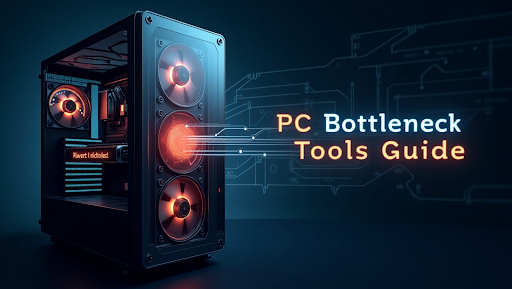
A bottleneck occurs when a PC component runs slower than it should because of another component. It provides information on why bottlenecks occur, how to identify them and why that is significant. We also consider well-known bottleneck calculators that can assist in finding and addressing issues with different hardware. If you repair your PC yourself, finding your computer’s primary issue will be more cost-effective and time-saving.
What results in a Bottleneck for Your Computer?
If one part in a PC’s hardware is restricting another, we describe that situation as a bottleneck. Sometimes, having a strong GPU won’t matter if the CPU is too slow, leaving the user to deal with noticeable lapses and a slow frame rate.
Typical Bottleneck Types Include:
- CPU Bottleneck: Where the processor is slow, which slows down the GPU or other components.
- GPU Bottleneck: Where the graphics card is the limiting factor in enhancement. This occurs prima facie in gaming at 4K settings. However, it may occur conditionally in investment projects.
- RAM or Storage Bottleneck: Less common, however, if memory is limited or drives are extremely slow, RAM and storage can bottleneck your system.
Identifying these bottlenecks enables you to create or upgrade a system with balanced performance across all its components.
Why Use a Bottleneck Calculator?
A Bottleneck calculator can prevent you from wasting money on expenses related to upgrading or building a PC. It helps by:
- Identifying Potential Hardware Mismatch
- Indicating component adjustments that can increase balance
- Providing a basis for real-world usage
- Identifying a performance estimator for gaming or productivity work
Whether you are a gamer, a video editor, or a data analyst, having an awareness of where your performance could be limited means you are making better investment decisions.
How Bottleneck Calculators Work
Most bottleneck calculators try to act on the processing power (clock speeds, threads, and architecture) of your CPU, compared to the frame processing capabilities of your GPU. It looks at how these two critical pieces get to work together, and then sums up performance with a bottleneck percentage.
While the specific formulas are commonly considered proprietary, a reasonable calculator should be able to identify them.
- CPU/GPU generation and architecture
- Total Thread/core count
- Clock speeds
- Total RAM – speed
- Resolution and Gaming Workload
You typically then get an output as a percentage (e.g., “Your CPU will bottleneck your GPU by 12%) and adjustments as well.
The Best Bottleneck Calculator Tools (Ranked and Reviewed)
Here’s a summary of the best and most accurate bottleneck calculators online for the most helpful and accurate calculator:
PC-Build’s Bottleneck Calculator
Website: pc-build.com/bottleneck-calculator
Overview: PC-Build’s calculator is one of the most comprehensive calculators online, allowing users to choose from a wide range of CPUs, GPUs, and memory configurations available on the market today. It uses your choice of resolution (720p to 4K) and use case (gaming versus productivity) to provide an estimated bottleneck percentage.
Pros:
- User-friendly interface
- Updated hardware database
- Supports multiple resolutions
- Provides scenario-based results
Cons:
- Older CPU models are slightly overestimated
- Limited awareness of RAM/storage bottleneck
Best For: Gamers planning a GPU upgrade
CPU Agent Bottleneck Calculator
Website: cpuagent.com
Overview: CPUAgent provides elaborate comparative benchmarks that include actual frame rates (FPS), latency, and power consumption. Top Bottleneck Calculator Tools is integrated into their CPU vs. GPU comparison tool, which is helpful for visualizing gaming workloads.
Pros:
- Provides elaborate data visualizations
- Covers gaming FPS across all titles
- Provides data on temperature, usage, and latency
Cons:
- Has a fairly small learning curve
- Less intuitive UI than some others
Best For: Advanced users, streamers, and users gaming at 1080p/1440p
Build Redux Bottleneck Analyzer
Site: buildredux.com/tools/bottleneck-analyzer
Overview: Build Redux is a stylish and modern tool, and it’s designed by a PC building service focused on offering the most simplified results for the average user. It tells you the bottleneck percentages and allows you to make changes to your build in real-time, based on those suggestions.
Pros:
- Clean UI
- Simple enough for beginners
- Provides advice on upgrades
Cons:
- Only provides estimates for modern hardware
- Does not take into account all resolutions
Best For: First-time builders and casual gamers
Tech PowerUp GPU/CPU Database + Estimates Bottleneck
Site: techpowerup.com
Overview: TechPowerUp is not exactly a Top Bottleneck Calculator Tools, but rather a site that has a wealth of details for each CPU or GPU, and it allows users to directly compare benchmark scores, so they are able to analyze their bottlenecks manually. So it’s a great site to support custom analysis.
Pros:
- Detailed data
- Regularly updated
- Benchmark for real-world usage
Cons:
- No auto-calc
- Users must interpret the data.
Best For: Enthusiasts who want to be in control of their data and have transparency over it
User Benchmark (with a grain of salt)
Site: userbenchmark.com
Overview: UserBenchmark is also quite controversial for its methods of ranking CPUs. However, they do have a reasonable bottleneck insight tool that shows performance gaps in real-world advice in gaming and desktop workloads.
Pros:
- Easy and free (and well used)
- Writes percentile rankings and gives scenario bottleneck warnings
Cons:
- UserBenchmark rankings are often biased toward Intel CPUs
- Doesn’t provide advice that is fully reliable for advanced decision making
Best For: Basic users who want a quick first look
When to use a bottleneck calculator?
Here are good times when using the bottleneck calculator Tools makes sense:
- Before you build a new PC, you want to make sure that your new hardware is compatible and that everything has a performance balance.
- If upgrading GPU/CPU, though you don’t want to buy something, you won’t be taking advantage of it.
- If you’re having performance problems while gaming, you may have mismatched hardware, causing issues such as stuttering or lag.
If you want to make sense of YouTube benchmarks, Bottleneck calculators can be contextually applied to whatever benchmark you may be watching.
Understanding the Bottleneck Results
Most tools will show you a percentage-based bottleneck value. For example:
- 0 – 10%: Good performance based on hardware
- 11 – 25%: Minimal bottleneck; parts performance likely won’t affect most games
- 26 – 50%: Performance noticeable bottleneck in selected applications
- 51% plus: Some upgrading or will need a new build
Always remember that context matters. A 20% CPU bottleneck on a 4K gaming example, like you may not even worry about it if you’re playing a CPU-light game. Likewise, a 15% GPU bottleneck may not even be relevant if you’re gaming on a better, yet lower resolution, such as 1080p on a 60Hz monitor.
Ways to Minimize System Bottlenecks
- Balance your build – Don’t have a $700 GPU with a $100 CPU
- Match resolution and performance – High-resolution gaming requires more GPU power
- Overclock safely – Overclock the CPU or GPU to minimize performance mismatches.
- Upgrade RAM or storage – Just “adding RAM” or “upgrading to SSD” doesn’t disregard the importance of memory speed, read/write speeds, and loss of performance from inadequate memory
- Close background applications – Software bottlenecks often look like hardware bottlenecks.
Final Thoughts
These calculators allow you to recognize what is limiting your computer’s speed. Because of this, people who create content or play games will find them useful for saving money and maintaining performance. They help you get started by providing an estimate of how well your CPU and GPU work together. Ensure that the options you find meet your requirements.
FAQs
What is the purpose of a bottleneck calculator?
To determine whether your CPU or GPU is throttling system performance.
Are bottleneck calculators accurate?
They provide an approximation that is best used in combination with real-world monitoring.
Can a bottleneck damage hardware?
No, but it can cause performance hits and depreciation of asset value.
How can I fix a bottleneck?
Either upgrade the part in question or tune usage settings accordingly.
Is a 10% bottleneck bad?
No, it is usually regarded as a normal amount that is typically undetected in real use.


